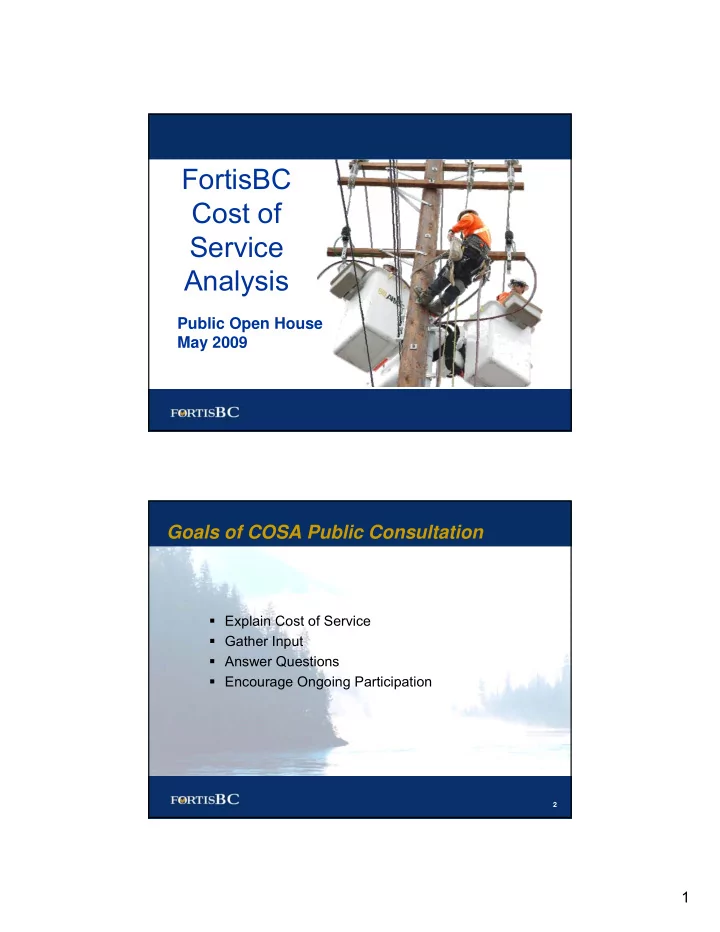

FortisBC Cost of Service Analysis Public Open House May 2009 1 Goals of COSA Public Consultation � Explain Cost of Service � Gather Input � Answer Questions � Encourage Ongoing Participation 2 1
The Public Consultation Process – “Who” � Residential customers � Industrial Customers � Commercial Customers � Municipal Utilities (Wholesale customers) � Customer Group Organizations � Government � First Nations � British Columbia Utilities Commission 3 The Public Consultation Process – “How” � General Communications � One-on-one communications � Meetings with wholesale and industrial customers � Open Houses and Information Sessions 4 2
FortisBC Profile � Oldest electric utility in British Columbia � 110,000 direct customers across BC’s southern interior � Provide power to 5 Municipal utilities (resellers) � Four hydroelectric generating stations � 7000 km of power lines, 65+ substations, � Kelowna-based head office, with over 14 field offices � Over 500 employees � Many different types of customers 5 FortisBC Cost of Service Analysis 6 3
Key Concept - Revenue Requirement Revenue Requirement = •Determines the revenue required to operate Power Supply the utility Operations & •Approved Annually by the Utilities Maintenance Commission Depreciation & Taxes Interest and Return •Basis for Annual Rate Adjustment 7 What is “Cost of Service Analysis” ? � The purpose of a Cost of Service Study is to break down the total Revenue Requirement to the Customer Classes. � The result of the Cost of Service Study shows the Cost to Serve each Customer Class. Why now? � Last done in 1997 � Many changes to the system and the industry. 8 4
Slicing the Revenue Pie Revenue Requirement – The “Size” of the Pie Residential Irrigation Lighting Commercial Wholesale Industrial Revenue Requirement 9 Overview – The COSA Process •The total dollars to collect. Revenue Requirement •Determine the costs that each customer class is causing and how much revenue the utility is Cost of Service Analysis collecting from each. Rate Design •How does the utility collect the costs? 10 5
Brief Overview of COSA Revenue Determine the revenue requirement of the Requirement utility Determination Step 1 Functionalize costs and services Cost of Service Step 2 Classify costs Analysis Step 3 Allocate costs among customer classes Design rates Rate Design 11 Step 1 - Functionalization 1. Functionalization Production Transmission Total Cost (Revenue Requirement) Distribution Customer 12 6
Steps in COSA 1. Functionalization 2. Classification Production Transmission Fixed (Demand) Total Cost (Revenue Requirement) Variable (Energy) Distribution Customer Direct Customer 13 Step 3 – Allocation of Costs � Cost allocation – the process of matching the different types of classified costs to different groups of customers � allocation factors proportion the costs on an equitable basis. � Example � Meter costs can be allocated based upon the number of customers in each class of service Class of Service Number of Customers % Residential 4,000 93.9% Commercial 250 5.9 Industrial 10 0.2% Total 4,260 100.0% 14 7
Steps in COSA 1. Functionalization 2. Classification 3. Allocation Production Transmission Demand (Fixed) Total Cost (Revenue Requirement) Energy (Variable) Residential Distribution Customer Commercial Industrial Direct Wholesale Customer 15 Then & Now Since 1997 the FortisBC system has changed in a number of ways: Significant investment in infrastructure � Customer load characteristics are different � Capacity Constrained � 16 8
Interpreting the COSA Results � The COSA results show the allocated cost that should be collected from rates for each customer class. � The revenue to cost ratios for each class show FortisBC is collecting the appropriate amount of revenue from each class. � COSA can be used to help design rates � Revenue neutral to the Utility 17 Results of FBC COSA � Revenue to Cost Ratios are used to show how much customers are paying relative to their allocated costs. 2009 Revenue To Cost Ratio Residential 97.1% Small GS (20) 111.9% General Service (21) 143.1% Industrial Primary (30) 125.9% Industrial Transmission 54.4% Lighting 84.8% Irrigation 81.3% Kelowna Wholesale 90.1% Penticton Wholesale 80.4% Summerland Wholesale 96.4% Grand Forks Wholesale 85.4% BCH Lardeau Wholesale 103.3% BCH Yahk Wholesale 104.9% Nelson Wholesale 82.3% 18 9
Results of FBC COSA 19 What is “Cost of Service Analysis” ? Determines, � How costs are divided among the customer groups. � Whether FortisBC is collecting the appropriate amount of revenue from each class. Now you know! 20 10
Next Steps –Rate Design Rate Design is the next logical step that comes after the Cost of � Service Analysis is complete. Some considerations: � (1) A public utility must not make, demand or receive (a) an unjust, unreasonable, unduly discriminatory or unduly preferential rate for a service provided by it in British Columbia,…. UCA Section 59 � Explore with B.C. utilities new rate structures that encourage energy efficiency and conservation. (2007 Energy Plan – Policy Action 4) 21 Rate Design Considerations � “Conservation” Rates � Revenue/cost ratio adjustments � Rate Relevance � Terms & Conditions Review 22 11
Rate Design Options Options to Consider � Flat Pricing � Inclining Block Rates � Time-of- Use Rates � Critical Peak Pricing � Customer Charge adjustments � Others 23 Regulatory Process 1. Cost of Service � Public Consultation Open Houses – Castlegar, Osoyoos, Kelowna � Feedback received by June 12 � � COSA Submission to BCUC – June 30, 2009 2. Final COSA & Rate Design � More Public Consultation � Rate Design Application to BCUC – September 30, 2009 24 12
Feedback � Sign-in sheets � Surveys � Website � Hand-out � E-mail: regulatory@fortisbc.com 25 Q & A � Questions / Comments ? 26 13
Recommend
More recommend